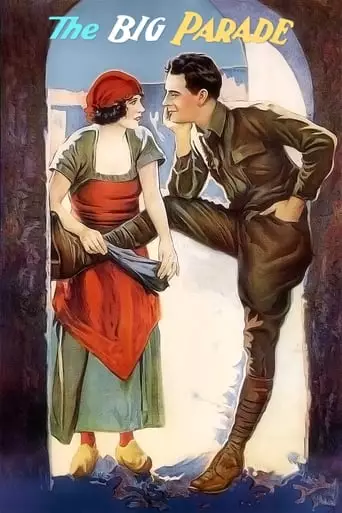
The Big Parade (1925) Watch Online Free
The story of an idle rich boy who joins the US Army’s Rainbow Division and is sent to France to fight in World War I, becomes friends with two working class men, experiences the horrors of trench warfare, and finds love with a French girl.
The Big Parade (1925), directed by King Vidor, is a seminal silent war film that offers a poignant portrayal of World War I through the eyes of an ordinary American soldier. The narrative centers on Jim Apperson (John Gilbert), a wealthy and carefree young man who enlists in the U.S. Army’s Rainbow Division. Sent to France, Jim is thrust into the brutal realities of trench warfare, where he forms deep bonds with fellow soldiers and experiences the profound horrors of combat.
The film’s structure is divided into three distinct acts:
Through this progression, the film delves into themes of personal growth, the futility of war, and the enduring impact of combat on the human psyche.
Upon its release, The Big Parade was a monumental success, both critically and commercially. It became MGM’s highest-grossing silent film, earning between $18 and $22 million, a substantial sum for the era.
The film’s realistic depiction of war set a new standard for war cinema, influencing countless subsequent films, including All Quiet on the Western Front (1930). Its candid portrayal of the horrors of war and the psychological effects on soldiers resonated deeply with audiences and critics alike. In 1992, The Big Parade was selected for preservation in the United States National Film Registry by the Library of Congress, recognizing its cultural, historical, and aesthetic significance.
After watching The Big Parade, you will likely feel a profound emotional impact, as the film invites deep reflection on the nature of war and its effects on the human psyche. The movie’s powerful portrayal of the horrors of World War I, particularly through the experiences of the protagonist, Jim Apperson, leaves a lasting impression. You may feel a sense of sorrow for the characters who face unimaginable suffering, loss, and trauma. The stark contrast between Jim’s naive pre-war life and the brutal reality of battle emphasizes the devastating transformation war imposes on individuals.
You might also feel a sense of admiration for the film’s emotional depth and the way it handles the psychological toll of war. Jim’s internal struggle as he tries to cope with the aftermath of his experiences is both heart-wrenching and relatable. The film doesn’t shy away from showing the complexity of human emotions, particularly the difficulty of reintegrating into civilian life after the horrors of war. The film’s portrayal of trauma and disillusionment may evoke feelings of empathy, as it highlights the personal cost of global conflict.
At the same time, the film’s underlying theme of friendship and camaraderie may leave you with a sense of hope. The bonds formed between Jim and his fellow soldiers provide a sense of solidarity amidst the chaos, showing that even in the darkest times, human connection can offer some solace. This theme of friendship is especially poignant in the face of death and destruction, reminding you of the importance of companionship and support during challenging times.
The romance between Jim and Melisande adds another layer of complexity to the film’s emotional tone. Their love story, though brief and overshadowed by the war, serves as a symbol of hope and beauty in an otherwise bleak world. After watching The Big Parade, you may feel a bittersweet sense of longing, as the love between Jim and Melisande represents what could have been in a world not ravaged by war.
In the end, The Big Parade will leave you with a sense of introspection. The film’s exploration of the futility of war, the resilience of the human spirit, and the enduring impact of combat challenges you to think critically about the cost of conflict and the value of peace. You may find yourself questioning the meaning of heroism, the consequences of violence, and the importance of personal integrity. The film’s emotional and intellectual depth will likely stay with you long after the credits roll, prompting reflection on the enduring relevance of its themes in today’s world.
Ultimately, The Big Parade is not just a film about war; it is a film about humanity. It invites you to consider the ways in which war shapes individuals and societies, and how, despite the overwhelming forces of violence and destruction, the human spirit can endure. After watching, you may feel a mix of sorrow, admiration, and reflection, all of which underscore the film’s enduring power as a classic of American cinema.
